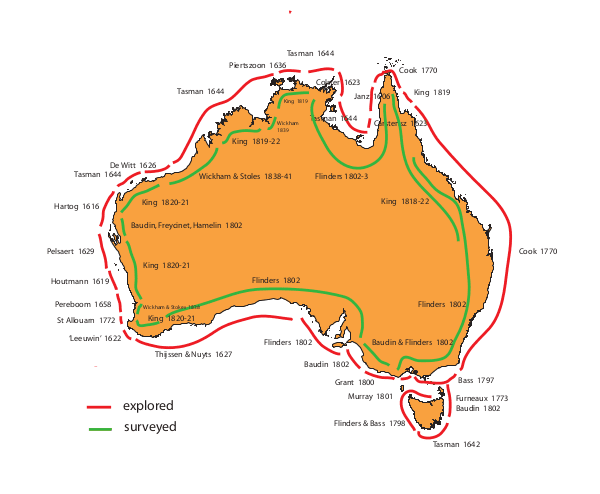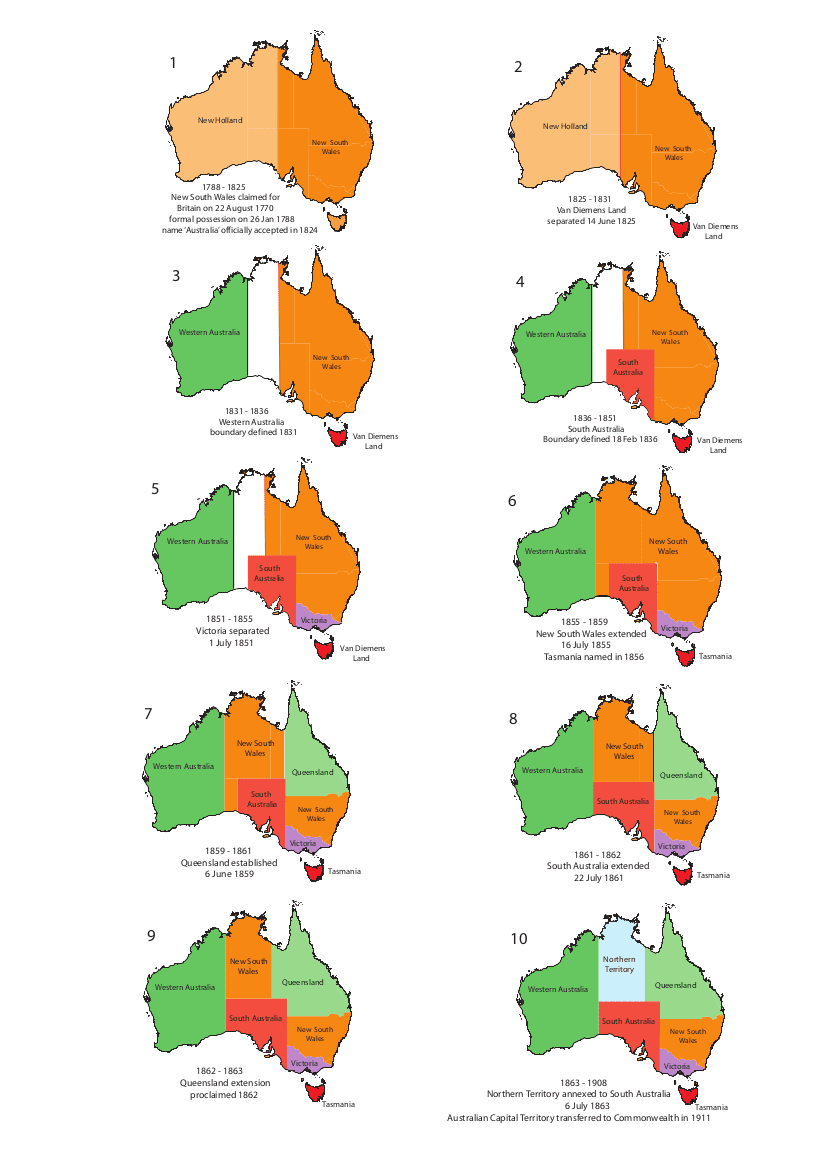
Australian botanical exploration

Courtesy Wikimedia Commons – Corey Leopold
Accessed 15 October 2020
Introduction – Australian Botanical Exploration
The series of articles in this section of the web site provides a brief overview of botanical exploration in Australia, mostly as it relates to systematic botany.
A full account of the history of systematic botany in Australia is given by Tony Orchard in the revised Volume 1 of the Flora of Australia (1999). This account by Tony Orchard, together with the synopses given in various state Floras, have provided most of the material for the articles here presented mostly state by state.
European settlement
The coastal mapping of New Holland initiated by the Dutch in the early 17th century was completed by the English and French, the first complete coastal chart of the continent being published by the French in 1807. From the first European sighting of New Holland this task extended over two centuries. Detailed coastal charts were not published by the British Admiralty until 1825.
With the establishment of an archipelago of coastal settlements it was time for explorers to establish the major physical features of the unknown interior of the continent and assess its potential for further settlement and exploitation. Coastal settlements around the continental margin had little contact and each major settlement is discussed separately here.
Botanical collectors
I have made a selection of some of the most prominent contributors to botanical science and those whose work captures the ‘flavour’ of the times in which they lived. The systematic botany content of the following account draws heavily on the work of Tony Orchard in Flora of Australia, vol. 1 pp. which also lists an extensive bibliography of the topic and many pages of individual profiles of voyagers, collectors, and botanists together with biographic details and their references.
At the time of settlement collection of botanical specimens was still part of the Botanophilia that was gripping European society, its citizens hungry for the ‘beautiful, curious and new’.[1] Natural history specimens were a lucrative commodity and demand for Australian plants in Europe was at a premium. Convicts (contrary to the orders of Joseph Banks) would sell specimens to people returning to England on the convict transports.[2]
Some of the early settler collectors, like David Burton, George Caley, William Baxter and Allan Cunningham were paid from England by nursery proprietors, botanic gardens, or private individuals. Others, like James Drummond and Franz Sieber were, in effect, botanical bounty hunters who sold their collections to the highest bidder. Yet others like Ronald Gunn and James Backhouse were self-supporting amateur botanical enthusiasts. Both the clergy and medical profession were encouraged to use their spare time constructively engaged in natural history pursuits and both made major contributions to early botanical collecting: in the former category are John White, Surgeon-General to the First Fleet, his assistant Dennis Considen, …. George Bass, Hans Behr, Hermann Beckler in the latter ?Colonial Chaplain Mr Johnson. … (botany/medicine link).
After the fleeting visits of the early merchants and buccaneers and the Enlightenment voyages of scientific exploration, there was a period after settlement when specimens were returned to the patrons, naturalists and institutions in Europe, mostly Britain, France, Holland and Germany, before scientific work could become a matter for the residents themselves.
Plants to Europe
Returning the plants to Europe was no simple matter as storing and transporting specimens by sea tested human ingenuity to its limits in a battle with mould, salt spray, insects and vermin, leading to inventions like the sealed glass case invented by Nathanial Ward that became known simply as the ‘Wardian Case’. Even so, many collections were lost with their ships and the success rate was dismally low.[1] For more than 60 years and dry, pressed herbarium specimens were returned to European herbaria, sometimes languishing there for many years before being classified and described. In contrast, seeds, cuttings, and living plants were quickly swept up by nurserymen, the major botanic gardens and for use on the estates of the wealthy.
Specimens returned to Europe were deposited in herbaria, at first private collections like that of Banks in his Sloane Square apartments, but later, repositories for dried plant specimens that could be studied and described by resident botanists – institutions like the Natural History Museum and Linnean Society Herbarium in London, the Edinburgh Herbarium, Natural History Museum in Paris. Here they were formally described by, among others: Germans Endlicher, Johann Lehmann and Carl Meisner; Britains John Lindley, Robert Brown, William Hooker and George Bentham; Frenchmen Labillardière, Aimee Bonpland and Etienne Ventenat; Russian Turczaninov. John Lindley whose father was a nurseryman was an assistant librarian to Banks, a member of the Royal Society and Professor of Botany at London University and later Cambridge University where the Lindley Herbarium contains many of the Australian specimens that he described, mostly the Drummond and Mangles’ collections from Western Australia and others from Mitchell’s Third expedition. Some of these were advertised through the Gardener’s Chronicle and Edward’s Botanical Magazine.
Resident botanists & herbaria
With settlement a new phase of resident botanical collectors had begun although it took a while for the new country to establish its own botanical expertise, facilities and equipment to study and house collections of the new flora within New Holland. However, by 1850 resident botanists, most notably Ferdinand Mueller, had established themselves and were supported by amateur naturalists, clergymen, geologists, educators and the like who were harnessed in the steady drive towards an inventory of the country’s plants. Herbaria had been established in Sydney, Melbourne … Explorers, Mueller included, were now venturing inland. Before long intrepid adventurers were attempting some of the world’s most ambitious overland expeditions ever as the harsh (to European sensibilities) inland deserts and were gradually revealed to men like Leichhardt, Sturt, Giles and Burke and Wills. Later, botanical collectors were often included on the intrepid overland explorations of people like Leichhardt …….
Overland exploration
Exploration of interior Australia corresponds roughly with a time when the planet’s major land masses, and indeed many of its minor ones, had been ‘discovered’ and their coastlines surveyed by Europeans. There followed a period of exploration of the interiors of the ‘new’ lands and the other unknown frontier, the deep seas, hitherto assumed to be completely barren.
A grand period of inland exploration in Australia was spurred by the excitement of finding an inland sea. In the early 1860s the centre was still an enigma, Sturt failing in his attemptedcrossing in 1845, Leichhardt swallowed up without trace in 1848 and the death of Burke and Wills in 1861.
Following the example of maritime exploration overland explorers competed for prestige by covering new ground. They were heroic figures sponsored by government prize money or public subscriptions whose departures and arrivals were attended by enormous and enthusiastic crowds. Their exploits were followed eagerly by the newspapers and, like the maritime explorers, they often had scientific and surveying experience, and included scientists in their parties, heir diaries and reports were generally published and as popular in Britain as they were in Australia.
With many specimens in Europe the definitive botanical account of its day George Bentham and Joseph Hooker persuaded Mueller to cooperate in what was probably the most monumental work on Australian botany the Flora Australiensis in volumes (1863-1878) a work which both inspired and provided the groundwork for the state floras that followed. Although it would have been an Australian triumph for the capable Mueller to have completed this work, but the botanical skills of George Bentham working at this time only from herbarium sheets have stood the test of time and won the admiration of subsequent generations of botanists. This was one of several similar works describing plants of the British colonies.
Deep sea
The British deep sea expedition of HMS Challenger (1872-1876), proposed by the Royal Society and accepted by the Admiralty, carrying the finest scientists and scientific equipment of the day at a time when Britain was at the peak of its imperial power. On board, as usual, was an artist but the new technology of photography was also employed. On this landmark expedition 362 stations around the world’s oceans were systematically sampled at many depths, the results marking the advent of scientific oceanography. Samples were taken off Sydney and its deepest sounding of 8,200 metres was made in the southwest Pacific. It marked perhaps the twilight period of the great global scientific voyages of exploration when science was its own justification. Scientific exploration would continue but now mostly initiated by the ‘discovered’ territories as the grip of colonial powers weakened.[4]
First published on the internet – 1 March 2019
Coastal charting and early coastal exploration
Historical determination of Australia’s internal political boundaries



